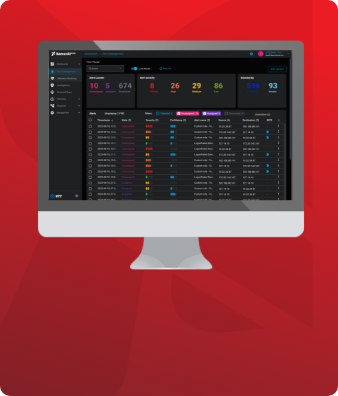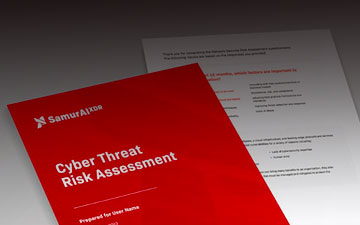The threat landscape is becoming increasingly complex, challenging companies’ cybersecurity defenses. Sophisticated threat actors are continuously evolving new techniques with which to subvert security and successfully gain access to protected IT systems. Once access is achieved, malicious entities can deliver malware or attempt to steal valuable data assets.
The rise of the remote workforce and the expansion of the Internet of Things has exacerbated the situation and made it more difficult to effectively protect an IT environment. Each endpoint represents an expansion of the attack surface that needs to be secured against cyberattacks.
What is an Attack Surface?
An organization’s attack surface can be defined as the sum of different points through which a threat actor can gain access. Minimizing the attack surface should be a basic component of a company’s cybersecurity strategy so you have the least number of points of exposure through which you can be exploited.
The attack surface is constantly evolving as new devices and software solutions are introduced into the environment. Companies undertaking digital transformation are doing more business online which expands their attack surface. Cloud applications and mobile apps used to support a mobile workforce are also responsible for increasing a company’s attack surface. A company’s attack surface can be further extended through relationships with third parties and the digital supply chain. In many cases, lax security in the digital supply chain offers opportunities for threat actors to exploit that are outside of an organization’s direct control.
As the number of potential entry points increases, it becomes harder to effectively defend them. Cybercriminals only need to identify a single vulnerability to successfully conduct an attack.
Three steps can help an organization develop a clearer understanding of what comprises its unique attack surface and can be instrumental in helping it defend itself against attack vectors.
- Visualization - Visualizing the organization’s systems and how they interact is the first step. All devices, networks, paths, and software solutions need to be incorporated to provide a comprehensive inventory of attack surface.
- Identify indicators of exposure - The next step is to identify indicators of exposure or potential vulnerabilities which could be used by an attacker to gain access. Potential entry points need to be prioritized according to their level of risk and defended to minimize the chances that a threat actor can breach security.
- Identify indicators of compromise - This step identifies attack vectors that have been exploited so improved security can be implemented to minimize additional exploitation. Threat actors should not be permitted to repeatedly use the same vulnerability. Understanding where and how successful attacks have been perpetrated provides important knowledge that can be used to ensure that the vulnerabilities are effectively addressed.
Examples of areas of the attack surface that need to be defended include:
- On-premises IT environments;
- A distributed network of IoT devices;
- Remote employees’ mobile devices;
- Web servers and web frameworks;
- Private, hybrid, or multi-cloud environment.
What are Attack Vectors?
Attack vectors, also known as threat vectors, are the methods or paths that threat actors employ to gain unauthorized entry into an IT system or environment. Specific attack vectors can be exploited automatically, manually, or through a combination of both.
Threat actors may use social engineering tactics to gain access to areas of a company’s attack surface. They may also exploit lax security measures to gain entry into the environment where they can plant malware or search for unsecured data resources.
Common attack vectors include:
- Phishing to trick unsuspecting users into performing a potentially dangerous activity;
- Malicious email attachments that when clicked deliver malware to the environment;
- Compromised credentials collected through phishing or other methods that permit entry to sensitive data;
- Weak passwords that enable successful brute-force attacks;
- System misconfigurations that do not adequately protect hardware and software resources;
- Malware such as ransomware that disrupts operations and put business-critical systems at risk;
- SQL injection to collect protected data from databases;
- Malicious insiders who have unfettered access to enterprise resources;
- Session hijacking in which unprotected session keys or cookies are used to gain access to the environment;
- Man-in-the-Middle attacks which intercept traffic and redirect it for malicious purposes.
As you can see, the combination of the wide variety of attack vectors and the extensive and changing attack surface made it extremely difficult to effectively protect an IT environment.
How Do Threat Actors Exploit Attack Vectors?
Threat actors have two basic methods of exploiting attack vectors.
- Passive attack vector exploits try to gain access without disturbing system resources. Once inside, they may move laterally through the environment as they try to obtain information without being detected. Examples of passive exploits include phishing and other types of social engineering attacks.
- Active attack vector exploits attempt to directly affect system operations and integrity. In this type of exploit, the threat actor is not concerned with being discovered. Examples include delivering ransomware, domain hijacking, and man-in-the-middle attacks.
Defending the Attack Surface
Effectively defending the attack surface requires both traditional and advanced cybersecurity solutions. While traditional cybersecurity measures remain essential, they are no longer enough to protect an environment from sophisticated threat actors.
The techniques used by today’s sophisticated cybercriminals are often designed to escape detection by traditional rule-based security solutions. Threat actors strive to leave weak signals and minimal traces of their incursions that are beyond the capabilities of legacy cybersecurity solutions to detect. Therefore, robust security demands a combination of traditional and advanced solutions and tactics.
Traditional security measures to defend against attack vectors include:
- Firewalls to exclude known threats from the environment;
- Strong password policies to limit unauthorized access to IT resources;
- Multi-factor authentication to guard against compromised credentials;
- Cybersecurity training to develop a high security IQ throughout the organization;
- Network and system monitoring to detect unauthorized access and intruders.
- Antivirus software to guard against known malware variants.
Advanced methods need to exhibit capabilities that go beyond those of traditional solutions. They should augment and not replace legacy cybersecurity measures. Extended detection and response (XDR) platforms offer additional abilities in identifying the signs of sophisticated threat actors so they can be addressed before causing damage to the infrastructure.
How XDR Improves Cybersecurity Defense
An XDR solution approaches cybersecurity from a holistic point of view which allows it to identify and consolidate weak signals from multiple parts of an IT environment. XDR provides a single pane of glass that consolidates all of an organization's alerts and simplifies managing and addressing them. Diverse and subtle signs of an intrusion can go undetected by traditional security measures and allow advanced persistent threats to remain in an environment for an extended time.
XDR uses data collected from the complete attack surface and threat intelligence (TI) to identify signs that may indicate the presence of a threat actor. By addressing the complete digital estate, an XDR solution enhances the visibility required to detect subtle threats and weak signals. The tool can identify the lateral movements of advanced persistent threats and alert security personnel so the intrusion can be addressed and removed from the environment while limiting damage.
Samurai’s XDR solution is a cloud-based solution that offers effective advanced security for companies of any size. Talk to the cybersecurity experts at Samurai and learn how their advanced XDR solution can help strengthen your defenses and better protect your attack surface against attack vectors and sophisticated threat actors.
Featured articles
Identity Management in the Physical and Digital Worlds
7 August 2024 | Webinars
In today's rapidly evolving world, managing identities securely and efficiently is more crucial than ever. Join us for an insightful...
Identity Management in the Physical and Digital Worlds
30 July 2024 | Webinars
In today's rapidly evolving world, managing identities securely and efficiently is more crucial than ever. Join us for an insightful...
XDR for Small and Medium Businesses: Is It Worth It?
24 July 2024 | XDR
Cybersecurity is of paramount importance to virtually all organizations and SMBs have to address several specific challenges. The failure to...





